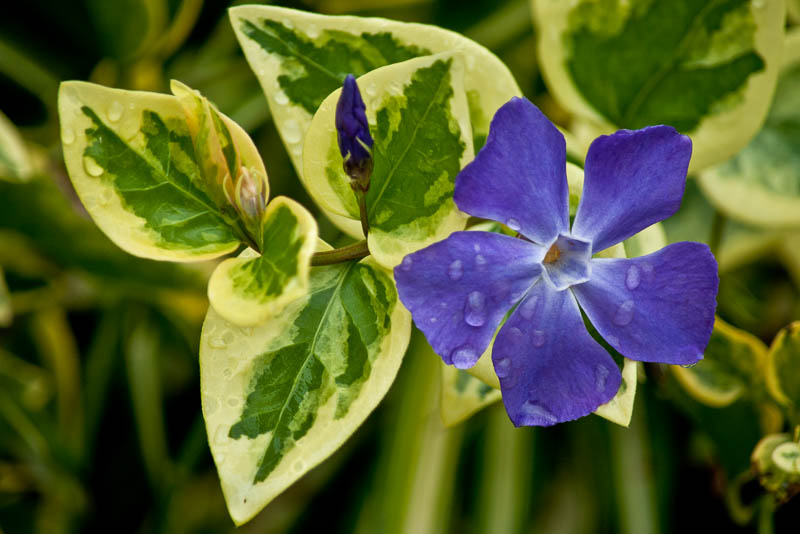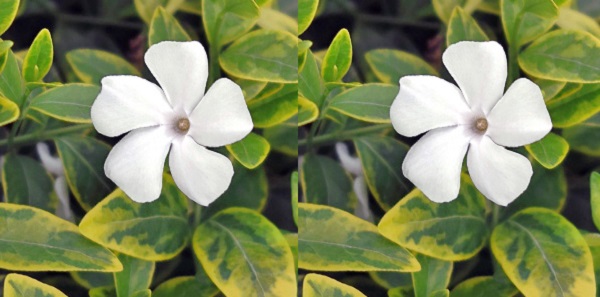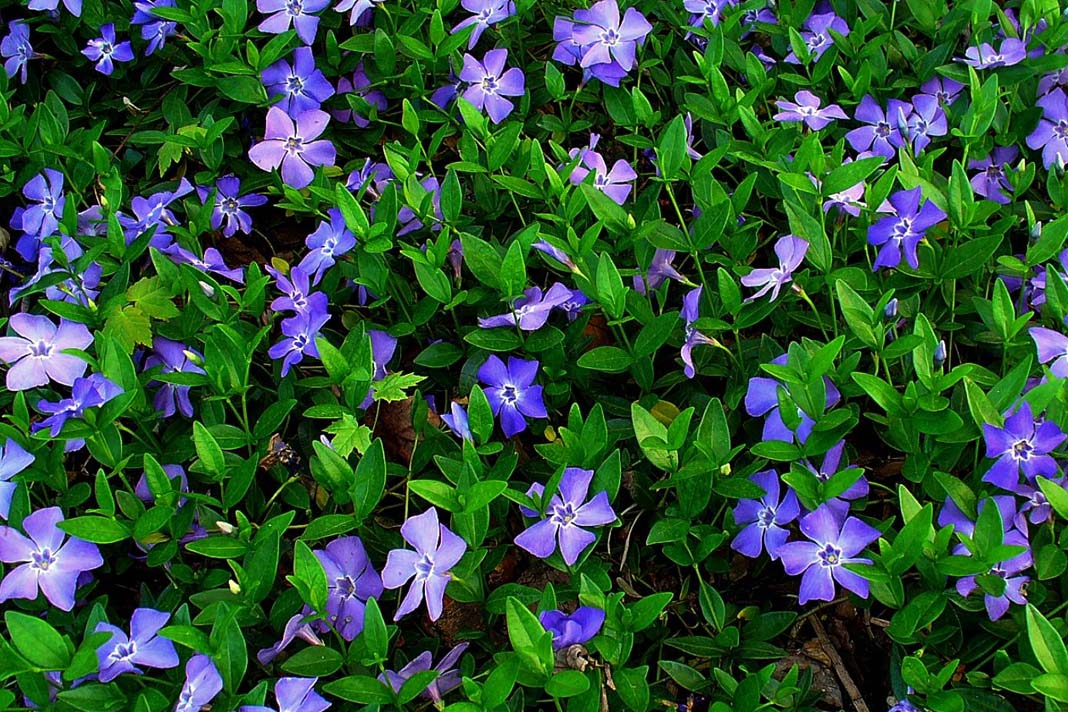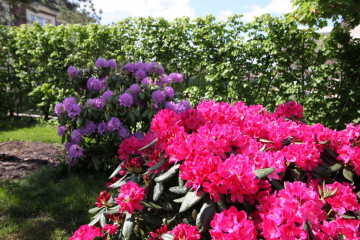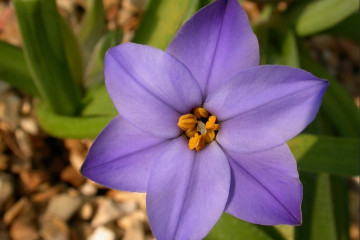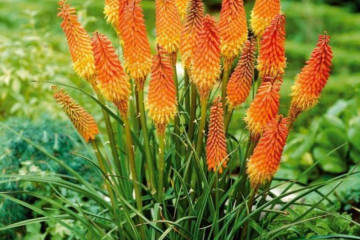Periwinkle - planting and care in the open field
Content:
Periwinkle is a flower that is very popular among amateur flower growers. Its sky-blue or pale lilac petals are able to charm at first sight. Many summer residents strive to grow this flower on their site.
Description Periwinkle: varieties and varieties
Periwinkle is a plant from the Kutrov family. It is a shrub or herb, a perennial with creeping shoots. It has beautiful and graceful leaves and flowers. Periwinkle creeps along the ground and covers it with a thick “carpet”.
This plant is very hardy - it grows even in the darkest and driest places.
As a rule, periwinkle is a blue, blue or purple flower, but there are also white, pink, red and purple colors. Its leaves can be colored in any of the shades of green.
In the Middle Ages, it was believed that this plant drives away evil spirits, so amulets were made from it. A periwinkle wreath was hung over the entrance to protect the house from lightning strikes. With the help of periwinkle, they wondered about love and marriage: if lovers want to never part, they must break and eat a leaf of periwinkle.
Description of varieties and varieties
Russian gardeners cultivate only some of the most popular varieties.
- Great periwinkle (Vinca major)
Small evergreen shrub that covers the soil. The height of its stem rarely exceeds 25 cm.
Its emerald green leaves are larger than all other species. It has bright petals with a diameter of about 5 cm, painted in a color called "pervance" (a shade of blue and light blue).
- Small periwinkle (Vinca minor)
An upright perennial herb with long (up to 1 meter) branches. It has strong glossy leaves 3–5 cm long and oval in shape and small bluish flowers about 2.5 cm in diameter.
A very beautiful variety "Alba" with delicate white petals. The elegant Ralph Shugert variety is widespread, with large, deep purple flowers and dark green oval-shaped leaves.
The leaves are edged with a white or silver border. There are also varieties with double flowers, golden leaves, red or white petals, and green leaves bordered with a white stripe. There are other subspecies: Bowles Variety, Dart's Blue, etc.
- Variegated periwinkle (variegated periwinkle)
One of the varieties of both large and small. Large wide green leaves are covered with yellow, beige or golden spots. The petals are blue, blue or lilac.
Variegated periwinkle is represented by many varieties, among which the most famous is the Illumination variety. There is a rare type of "Alba variegata", the leaves of which are crowned with a white border.
- Periwinkle herbaceous
It has numerous creeping shoots. On a thin stem are purple or blue flowers in the shape of stars and small green leaves.
This perennial thermophilic plant needs good shelter for the winter. Grows in meadows, glades, mountain slopes, in the steppe.
- Periwinkle straight
A herbaceous plant that lives on mountain slopes and in rocky areas. It has erect stems 15–50 cm high, green leathery leaves and white, light blue or pink flowers.
- Pink periwinkle (catharanthus)
A semi-shrub 60 cm high with large (up to 4 cm in diameter) light scarlet or pink flowers. A white vein is visible in the middle of the dark green leaves. It is convenient to grow it in an apartment.
Planting site, soil
If we talk about such a useful plant as periwinkle, planting and care in the open field does not require significant effort. This flower thrives on both sunny and shady areas.
For planting, you can choose a shaded place, for example, under the crowns of tall trees, because direct sunlight can burn leaves and petals. Periwinkle should be planted in fertile, loose soil with good drainage. Slightly acidic or neutral soil is ideal - the pH level should not exceed the 6 mark.
You cannot plant this flower in heavy and dense clay soil. Places where groundwater is close to the surface of the earth are not suitable for planting: the roots of the flower can rot.
The substrate must be prepared from equal parts of humus, sand, peat and turf. It is necessary to add fertilizers: nitrogen, phosphorus, compost or manure. This stimulates the growth of roots and branches and provides the plant with nutrients.
Seed planting
Seed propagation is an extremely time consuming and laborious process. It is necessary to fertilize and loosen the soil on a shaded plot of land, put drainage on the bottom (crushed stone, sand, expanded clay) and prepare the seeds.
How to sow seeds:
- When digging up a bed, add a little compost to the soil.
- On the site, make thin grooves 1 cm deep.
- Sow each seed, sprinkle lightly with soil and water.
Periwinkle seeds can be propagated in spring or autumn. To do this in the summer, you need to choose a cloudy day for sowing. The plant will bloom only next year.
With this method, not all seeds germinate, so most gardeners propagate periwinkle by cuttings.
Planting seedlings
Many growers grow periwinkle from seeds in greenhouses or in a box in an apartment. When warm weather sets in and strong seedlings with a good root system appear, they are transplanted into open ground.
It is very convenient to propagate the plant by cuttings. Periwinkle creeps along the ground, so in some places the branches release roots. You need to cut off the stalk and dig it into the ground. Soon it will take root. Seedlings and cuttings should be planted in an area of 20 × 20 cm. The flower should be planted in spring or late autumn.
Watering and loosening the soil
Every plant needs attention and care, even one as unpretentious as periwinkle: but planting and leaving will not take much time, and the result will delight the owner.
Watering the periwinkle is necessary only on hot dry days. In rainy weather, additional watering is not required. It is necessary to regularly loosen the soil and weed weeds.
Reproduction methods
Periwinkle can reproduce in three ways:
- layering;
- seeds;
- cuttings.
The first method is most often chosen because of its simplicity.
How to propagate by layering:
- Where branches touch the ground, roots often sprout on their own.
- If this does not happen, you need to dig part of the shoot into the ground. After a while, the layers will take root.
- When the branch takes root, the cut is cut off and transplanted.
Top dressing and transplanting
You only need one feeding with organic or complex mineral fertilizer. The rest of the time, the flower will receive a sufficient amount of nutrients from the soil. Pink catharanthus should be fertilized 2 times a month in spring and summer.
Old, discolored and too long shoots should be trimmed and pinched. After that, they begin to grow in width.
Periwinkle is transplanted in early spring. There must be a distance of at least 25 cm between the bushes.
Indoor periwinkle can grow in pots, hanging planters, flowerpots, but cultivation and care have one feature. It must be regularly transplanted into a larger pot: roots and shoots grow rapidly, so an annual transplant is required.
Pests and diseases
The periwinkle has a strong immune system that protects it from most diseases. For this plant, fungal infections, especially rust, pose a great danger. Branches and leaves are covered with orange bloom. The affected parts must be cut off and burned. For treatment, fungicides are used. The plant must be sprayed three times at intervals of 14 days.
This flower can be bothered by pests, especially aphids. It is necessary to rinse the entire plant with soapy water or lemon peel tincture. In difficult situations, insecticides are used.
Flowering period and care after
Periwinkle blooms in late May and early June. Flowering lasts about 30 days. Some varieties can bloom twice a year - in spring and autumn.
At this time, the plant must be carefully looked after, but no specific care is required. It is necessary to water as needed, and also to pinch strongly elongated shoots.
After the end of the flowering period, a strong pruning of the shoots is carried out. You can collect seeds and try to grow new flowers from them.
How to prepare for wintering
Periwinkle is a perennial plant that lives for at least 10 years. The frost-resistant flower is able to withstand short frosts.
Variegated varieties need winter shelter. The plant is covered with spruce branches, then semicircular metal supports are placed above it and covered with a special non-woven insulation, and on top of it - with plastic wrap. Cold winters without snow are especially dangerous for this flower.
Use in landscape design
Periwinkle is a grass or creeping shrub that easily covers the soil. It is very often used in gardening and landscaping. Expanding in width, it spreads along the ground and covers it with a thick carpet.
Small and delicate periwinkle flowers will decorate the garden and give it a touch of touching vulnerability and, at the same time, resilience. This plant can be grown on slopes and hills, as well as on rocky soil: its contrast with boulders and stones will look very beautiful and impressive.
It is advisable to plant this flower under tall trees or in the lower part of a multi-tiered flower bed. It creates the perfect backdrop for large flowers and shrubs. It can be grown in hanging pots as an ampelous plant. The neighborhood of periwinkle with such flowers as heliantemum (sunflower), saponaria (soapwort), saxifrage will look very harmonious.
Beneficial features
Small periwinkle has many useful properties. On its basis, various medicines are made: devinkan, vinpocetine, vincapan, vincanor, etc. It contains many alkaloids that have a beneficial effect on the vessels of the brain and normalize blood circulation.
Beneficial features:
- improves cerebral circulation;
- expands the vessels of the brain, increases their tone, relieves spasms;
- lowers blood pressure;
- improves the condition of the heart muscle (myocardium);
- reduces the affected area in ischemic stroke;
- has sedative properties, therefore it is useful for tachycardia, depression, encephalitis, stress, neurosis;
This herbal remedy helps with stages 1 and 2 of hypertension, eye diseases and ENT diseases.
Pink periwinkle contains antineoplastic alkaloids, therefore, drugs used in chemotherapy of oncological diseases are made on its basis - vincristine, vinblastine, vinorelbine.
The health benefits of periwinkle can hardly be overestimated. Its healing properties were known in ancient times.
A modest but elegant periwinkle grows in many parts of the world. This ground cover flower is unpretentious and can live for many years and even decades. It can be grown outdoors or in a hanging basket.

